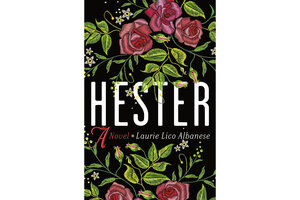‘Hester’ imagines a backstory to Hawthorne’s ‘The Scarlet Letter’
Hester Prynne refused to be shamed for her actions in “The Scarlet Letter.” Was Hawthorne writing about someone he knew?

"Hester," by Laurie Lico Albanese, St. Martin's Press, 322 pp.
Ever wonder if a real woman might have inspired Nathaniel Hawthorne’s Hester Prynne? On rereading “The Scarlet Letter” as an adult, novelist Laurie Lico Albanese was so taken with its heroine, “who defies powerful men and vengeful villagers by wearing the symbol of her shame like a badge of courage,” that she fabricated a backstory behind the classic. Her new novel is colorful, in more ways than one.
“Hester” is told from the point of a view of Isobel McAllister Gamble, a young Scottish woman stuck in an unfortunate marriage. Soon after she immigrates to America, Isobel falls hard for the handsome, haunted, aspiring writer Nat Hathorne (the “w” in his last name was added later). She announces boldly at the start of her tale: “The true story of how he found his scarlet letter – and then made it larger than life – begins when I was a child in Scotland and he was a fatherless boy writing poetry that yearned and mourned.”
Set in 19th-century Glasgow, Scotland, and Salem, Massachusetts – with flashbacks to 17th-century witch hunts in both places – “Hester” is a chronicle of ill-fated passion and female persecution. The book explores the weight of family history as Isobel and Nat each grapple with an ancestor’s role in the witch trials, one accused, the other an unrepentant prosecutor. Albanese’s consideration of inherited guilt also encompasses questions about culpability for forebears’ enrichment through slave trade and labor. (One of the novel’s surprising subplots involves efforts to outfox bounty hunters on the trail of enslaved people who had escaped. The hunters were permitted by law to pursue their human prey even in the supposedly free North.)
With “Hester,” Albanese has tapped into a rich vein of historical fiction that reimagines famous novels from a female character’s point of view. “Hester” joins books like Jean Rhys’ “Wide Sargasso Sea” (1966), which imagines a backstory behind Rochester’s “mad” first wife from Charlotte Brontë’s “Jane Eyre”; Sena Jeter Naslund’s “Ahab’s Wife” (1999), which offers a fresh angle on Herman Melville’s “Moby Dick”; and Christina Baker Kline’s “A Piece of the World” (2017), inspired by Andrew Wyeth’s iconic painting, “Christina’s World.” Like these novels, “Hester” dramatizes the challenges for women seeking freedom and autonomy in a male-dominated world.
Albanese reminds us in an author’s note that of the five novels Hawthorne published in his lifetime, “The Scarlet Letter” is the only one whose source of inspiration remains murky. Conjectures that Hawthorne shared more with his hypocritical clergyman Arthur Dimmesdale than he ever let on, and that his book was written as a veiled penance, underlie the plot of “Hester.”
Albanese’s version of the woman who inspired Hester Prynne will appeal to contemporary readers as both a proto-feminist and a forceful single mother. She comes from a long line of red-haired Isobels, beginning with the healer Isobel Gowrie, who barely escaped the murderous zealotry of witch-hunters in 17th century Scotland. One hundred and fifty years later, young Isobel, a gifted needlewoman, dreams of her own escape from the limited options open to women; her greatest desire is to own a dressmaking shop. Alas, she has hitched her star to Edward Gamble, an apothecary with a ruinous penchant for poppy that lands the couple in debtor’s prison. After Isobel’s father bails them out, they sail to Salem in 1829 in hopes of a fresh start. Things don’t turn out as planned.
In addition to her extraordinary talent for embroidery, Isobel is blessed – or cursed, in her late mother’s opinion, who feared its association with sorcery – with what we now know as synesthesia. Isobel’s form of this sensory phenomenon of “joined perception” leads her to associate sights, sounds, words, and letters with specific colors. Fittingly for the purposes of this novel, she associates the letter A with the color scarlet. But in a move that feels too much like narrative convenience, she signs all her needlework with a tiny, hidden scarlet letter A – not for adultery, but for Abington, her birthplace beside the River Clyde in Scotland.
Because most of Isobel’s experiences are literally tinted by the hues she associates with them, the novel is awash in color. Isobel hears her beloved father’s voice as soft caramel, her mother’s as sapphire and emerald. Most women in the book, however, generally speak in pastels. When Nat touches her, Isobel sees “explosions of color… persimmon, cinnamon, India-ink blue, lemon yellow, poppy red, tangerine.”
Unfortunately, weaving this unusual condition into the narrative comes to feel like a heavy-handed distraction. “Hester” is already richly threaded with so many details, including vivid pictures of life in the bustling port town of 19th century Salem, where newcomers are not welcome and a young redhead with a brogue, however highly skilled, is spurned by employers. While Isobel’s way of seeing leads to rainbow gardens and vibrant tapestries that map her life story, it also leads to some – I hate to say it – purple prose.
Albanese’s Hathorne is an intriguing character who does not come across well: He is a cad, both cowardly and arrogant. Still, he is not the worst person in “Hester.” Yet Albanese carefully offsets these villains with a wonderful, multiracial cast of supportive, heroic men and women whom Isobel comes to love. Her refusal to be a victim or to allow her daughter to become an object of scorn turns “The Scarlet Letter” on its head. “Hester” is an inspirational tale about the importance of self-determination and the power of women joining together to overcome oppression in its many forms.
Heller McAlpin reviews books regularly for The Monitor, The Wall Street Journal, and NPR.

